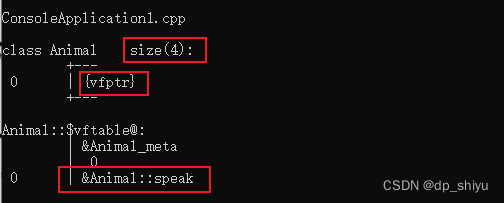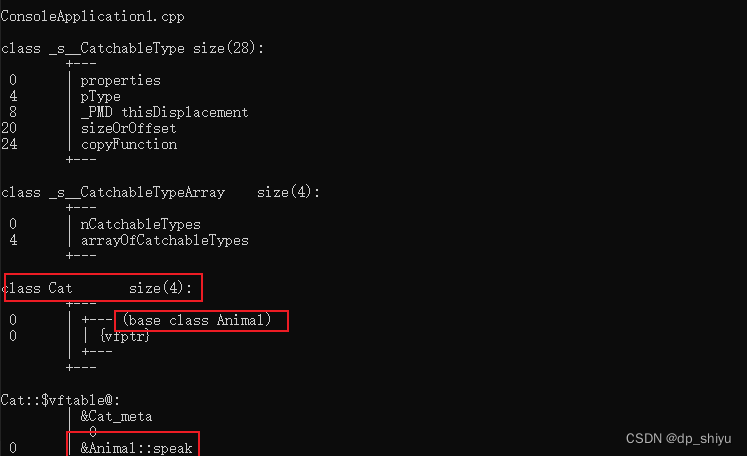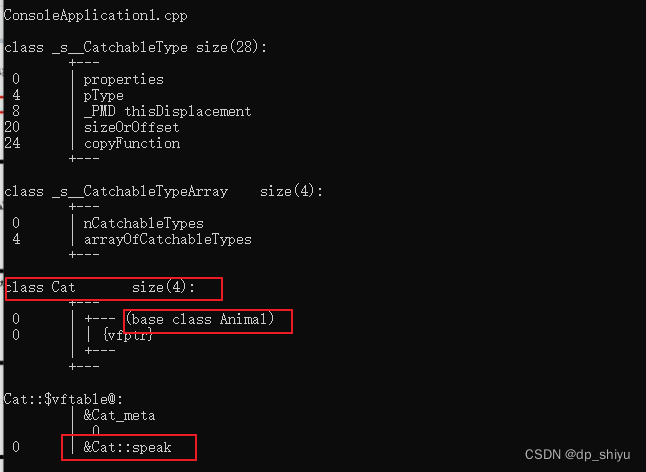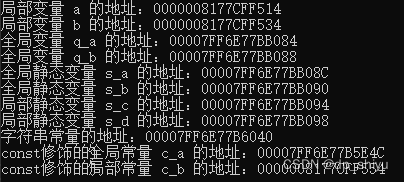后槽牙都要给我干稀碎之C++入门学习笔记
C++入门学习笔记-牙齿碎了也得给我咽下去!
- C++入门学习笔记-牙齿碎了也得给我咽下去!
-
- 基础之旅
-
- C++编译软件安装
- 变量Variables
- 常量
- 标识符命名规则
- 数据的输入cin
- 方法Function
-
- 方法定义默认值
- 方法的占位参数
- 头文件Header Files
- 使用Visual Studio 调试(Debug)程序
- 循环
- 条件分支
- 三目运算符
- switch语句
- 数组
- 指针
- 随机数
- 类class
-
- 封装
- 继承
-
- 继承方式
- 继承中的对象模型
- 继承的构造和析构执行顺序
- 同名成员处理
- 多继承语法
- 菱形继承问题以及解决方式
- 多态
-
- 纯虚函数和抽象类
- 虚析构和纯虚析构
- 静态成员
- 类和对象
-
- 成员函数和成员变量分开存储
- this指针概念
-
- this指针的用途
- 空指针访问成员函数
- const修饰成员函数
- frend 友元
- 运算符重载
-
- 加号运算符重载
- 左移运算符重载
- 递增运算符重载
- 赋值运算符重载
- 关系运算符重载
- 函数调用运算符重载
- 结构体Structs
- static
- 枚举Enums
- 构造函数Constructors
-
- 构造函数的分类
- 拷贝构造函数使用时机
- 构造函数调用规则
- 深拷贝与浅拷贝
- 初始化列表
- 类对象作为类成员
- 析构函数Destructors
- 继承Inheritance
- 虚函数Virtual Functions
- 纯虚函数(接口)
- 访问控制
-
- private 私有
- public 公有
- protect 保护
- C++文件操作
-
- 读文件
-
- 读文本文件
- 读二进制文件
- 写文件
-
- 写文本文件
- 写二进制文件
- 进阶内容
-
- 内存分区模型
-
- 程序运行前
- 程序运行后
-
- 栈区
- 堆区
- new操作符
- 引用
-
- 引用的注意事项
- 引用做函数参数
- 引用做函数返回值
- 引用的本质
- 常量引用
- 练习案例
-
- 案例1:基于结构体的控制台通讯录管理系统
C++入门学习笔记-牙齿碎了也得给我咽下去!
基础之旅
C++编译软件安装
变量Variables
变量存在的意义:方便我们管理内存空间
变量创建的语法:数据类型 变量名称 = 变量初始值;
int main()
{
char c;
unsigned char uc;
short s;
int i;
long l;
long long ll;
float f;
double d;
}
| 数据类型 | 占用空间 | 取值范围 |
|---|---|---|
| short | 2字节 | (-2^15-2^15-1) 即(-32768,32767) |
| int | 4字节 | (-2^31-2^31-1) |
| long | windows 为4字节,linux为4字节(32位)、8字节(64位)节 | (-2^31-2^31-1) |
| long long | 2字节 | (-2^63-2^63-1) |
| float | 4字节 | 7位有效数字 |
| double | 8字节 | 15-16位有效数字 |
常量
用于记录程序中不可更改的数据
C++定义常量的两种方式:
①:#define 宏常量:#define 常量名 常量值,通常定义在文件上方
#include ②:const修饰的常量:const 数据类型 常量名 = 常量值,通常在变量定义前加关键字const,修饰该变量为常量,不可修改
#include 标识符命名规则
- 标识符不能是关键字
- 标识符只能由字母、数字、下划线组成
- 第一个字符必须是字母或者下划线
- 标识符中字母区分大小写
数据的输入cin
#include 方法Function
将一段经常使用的代码封装起来,减少重复代码
语法:
返回值类型 函数名(参数列表)
{
函数体语句
返回值语句
}
方法定义默认值
- 如果一个函数某个位置参数有默认值,那么从这个位置往后所有的参数都必须设定默认值
- 如果一个函数声明时有默认值,那么函数实现的时候就不能有默参数
方法的占位参数
C++中函数的形参列表里可以有占位参数,用来做占位,调用函数时必须填补该位置
- 函数占位参数,占位参数也可以有默认值
- 占位参数调用时,没有默认值则必须填补
头文件Header Files
使用Visual Studio 调试(Debug)程序
循环
while循环
#include while循环模拟一个控制台菜单的选择,选择退出后菜单退出,否则仅输出选择了菜单的什么项:
#include 案例:水仙花数
#include for循环
#include 案例:敲桌子,从1开始数到数字100,如果数字个位含有7,或者十位含有7,或者该数字是7的倍数,我们打印敲桌子,否则仅输出该数字
#include 条件分支
案例:有三个数字,使用条件分支实现获得三个数字中的最大值
#include C++中三目运算符返回的是变量,可以继续赋值
#include 三目运算符
#include switch语句
#include 数组
#include 案例:一维数组元素逆置
#include 指针
指针的作用:可以通过指针间接访问内存
- 内存编号是从0开始记录的,一版用十六进制数字表四
- 可以利用指针变量保存地址
#include 指针所占的内存大小跟操作系统位数有关:32位操作系统占用4字节,64位操作系统占用8字节
空指针:
指针变量指向内存中的编号为0的空间,用于初始化指针变量,空指针指向的内存是不可以访问到
#include 野指针:指针指向非法的内存空间
const修饰指针:
- const修饰指针 — 常量指针(指针指向的地址可以改变,指向地址的值不可以改变)
- const修饰常量 —指针常量(指针指向的地址不可以改变,指针指向地址的值可以改变)
- const既修饰指针,又修饰常量(均不可以更改)
指针和数组
#include 指针和函数
值传递(形参会改变,实参不会改变)和地址传递(形参和实参均改变)
随机数
#include 类class
C++面向对象的三大特性:封装、继承、多态
封装
- 将属性和行为作为一个整体,表现生活中的事物
- 将属性和行为加以权限控制
语法:
class 类名 { 访问权限:属性 / 行为 };
案例:设计一个圆类,求取圆的周长和面积
#include 继承
继承可以减少代码量
class A : public B
A类称之为子类或派生类
B类称之为父类或基类
派生类中的成员包含两部分:
- 一类是从基类继承过来的,一类是自己增加的成员
- 从基类继承过来的表现其共性,而新增的成员体现了其个性
继承的语法:
class 子类 : 继承方式 class 父类
继承方式:
- 公共继承
- 保护继承
- 私有继承
继承方式
- 公共继承
父类的私有属性不可以被访问
父类公共属性在子类中依然是公共属性
父类中保护属性在子类中依然是保护属性 - 保护继承
父类的私有属性不可以被访问
父类公共属性在子类中是保护属性
父类中保护属性在子类中是保护属性 - 私有继承
父类的私有属性不可以被访问
父类公共属性在子类中是私有属性
父类中保护属性在子类中是私有属性
#include 继承中的对象模型
#include 私有成员只是被隐藏了,但是还是会继承下去
父类中所有非静态的成员都会被继承下去,包括同名的成员
查看类的分布情况:
c1 /d1 reportSingleClassLayout + 类名 类所在的文件名
需要打开vs编辑器中开发者提示工具 Developer Command Prompt for VS 2022
cl /d1 reportSingleClassLayoutChildren ConsoleApplication1.cpp
继承的构造和析构执行顺序
#include 同名成员处理
- 访问子类同名成员,直接访问即可
- 访问父类童名成员,需要添加作用域
#include 成员函数同上调用方式!
如果子类中出现和父类同名的成员函数,子类的同名成员会隐藏掉所有的父类同名的成员函数
多继承语法
C++允许一个类继承多个类,多个类之间使用逗号隔开
语法:class 子类 : 继承方式 父类1, 继承方式 父类2 …
多继承可能会引发父类中有同名成员出现,需要加作用域区分
C++实际开发中不建议使用多继承
菱形继承问题以及解决方式
两个派生类继承同一个基类
又有个派生类同时继承两个派生类
这种继承方式称为菱形继承,又称为钻石继承
vbptr 指向虚基类表
#include 多态
多态分为两类:
- 静态多态:函数重载和运算符重载属于静态多态,复用函数名
- 动态多态:派生类和虚函数实现运行时多态
静态多态的动态多态的区别:
- 静态多态的函数地址早绑定 - 编译阶段确定函数地址
- 动态多态的函数地址晚绑定 - 运行时阶段确定函数地址
#include 通过关键字virtual ,方法的地址将实现晚绑定,实现子类的动作行为实现
虚函数子类重写方法可加virtual 关键字也可不加,不影响最终结果
动态多态的满足条件:
- 有继承关系
- 子类重写父类的虚函数
虚函数表指针:
父类的虚函数会创建一个虚函数指针,指向虚函数表,表内会记录一个虚函数地址
当子类重写父类的虚函数,子类中的虚函数表内部会替换成子类的虚函数地址
当父类的指针或引用指向子类对象时候,发生多态

当子类Cat没有重写父类的虚函数时:

当子类Cat重写了父类的虚函数时:

案例:使用多态实现一个模拟的计算器类
#include 纯虚函数和抽象类
在多态中,通常父类中的虚函数实现是毫无意义的,主要都是调用子类重写的内容
因此可以将虚函数改为传虚函数
class AbstractCalculator
{
public:
int num_1;
int num_2;
public:
//纯虚函数
//只要类中有一个纯虚函数,那么这个类就是一个抽象类
virtual int getResult() = 0;
};
抽象类:
- 无法实例化对象
- 抽象类的子类 必须要重写父类中的纯虚函数,否则也属于抽象类
案例:模拟煮茶水和泡咖啡的流程
#include 虚析构和纯虚析构
多态使用时,如果子类中有属性开辟到堆区,那么父类指针在释放时无法调用到子类的析构代码
解决方式:将父亲中的析构函数改为虚析构或者纯虚析构
#include 虚析构和纯虚析构共性:
- 可以解决父类指针释放子类对象
- 都需要有具体的函数实现
虚析构和纯虚析构区别:如果是纯虚析构,该类属于抽象类,无法实例化对象
虚析构语法:virtual ~类名(){}
纯虚析构语法:virtaul ~类名() = 0; 类名::~类名(){}
案例:实现一个计算机的运作过程,展示不同的设备与厂家之间的关系
#include 静态成员
静态成员就是在成员变量和成员函数前加上关键字static,成为静态成员
静态成员分为:
- 静态成员变量
- 所有对象共享同一份数据
- 在编译阶段分配内存
- 类内声明,类外初始化
#include 静态成员变量也是有访问权限的
- 静态成员函数
- 所有对象共享一个函数
- 静态成员函数只能访问静态成员变量
#include 类和对象
成员函数和成员变量分开存储
空对象占用内存为1个字节
C++编译器会为每个空对象也分配一个字节的空间,是为了区分空对象占用内存的位置
每个空对象也应该有一个独一无二的内存地址
#include 非静态成员变量内存属于类的对象上
静态成员变量内存不属于类的对象上
成员函数内存不属于类的对象上
#include this指针概念
每一个非静态成员函数只会诞生一份函数实例,也就是多个同类型的对象会共用一块代码
C++通过提供特殊的对象指针,this指针,解决是哪个对象调用成员函数的
this指针指向被调用的成员函数所属的对象
this指针是隐含每一个非静态成员函数内的一种指针
this指针不需要定义,直接使用即可
this指针的用途
- 当形参和成员变量同名时,可以用this指针来区分
#include - 在类的非静态成员函数中返回对象本身,可以使用 return *this
#include 空指针访问成员函数
空指针可以访问成员函数,但是当访问到的成员函数有调用this时,将会出现异常
在成员函数中进行判空的操作可以加强程序的健壮性
const修饰成员函数
常函数:
- 成员函数后加const后我们称这个函数为常函数
- 常函数内不可以修改成员属性
- 成员属性声明时加关键字mutable后,在常函数中依然可以更改
常对象:
- 声明对象前加const称为该对象为常对象
- 常对象只能调用常函数
#include frend 友元
在程序中,有一些私有属性也想让类外特殊的一些函数或者类进行访问,就需要用到友元的技术
友元的目的就是让一个函数或者类访问另一个类中私有成员
友元的三种实现:
- 全局函数做友元
#include - 类做友元
#include - 成员函数做友元
#include 运算符重载
对已有的运算符重新进行定义,赋予其另一种功能,以适应不同的数据类型
加号运算符重载
实现两个自定义数据类型相加的运算
运算符重载也可以发生函数重载
#include 左移运算符重载
//
递增运算符重载
//
赋值运算符重载
//
关系运算符重载
//
函数调用运算符重载
//
结构体Structs
结构体属于用户自定义的数据类型,允许用户存储不同的数据类型
语法:
struct 结构体名称 { 结构体成员列表 };
通过结构体创建变量的方式有三种:
- struct 结构体名称 变量名称 stu
- struct 结构体名称 变量名 = { 成员1值,成员2值 } stu_2
- 定义结构体时顺便创建变量stu3
#include 结构体数组:
#include 结构体指针:
利用操作符 -> 可以通过结构体指针访问结构体属性
结构体嵌套:
#include 结构体中使用const关键字:
节省内存且防止修改结构体的内容信息
static
枚举Enums
构造函数Constructors
构造函数主要作用于创建对象时为对象的成员属性赋值,构造函数由编译器自动调用,无需手动调用
#include 构造函数的分类
两种分类方式:
- 按照参数分为:有参构造和无参构造
- 按照类型分为:普通构造和拷贝构造
#include 三种调用方式:
- 括号法
- 显示法
- 隐式转换法
int main()
{
//括号法调用
Circle circle_default; //默认构造
Circle circle(12); //有参构造
Circle circle_copy(circle); //拷贝构造
//显示法调用
Circle circle_2 = Circle(12);
Circle(12); //匿名对象 当前行执行结束后,系统会立即回收掉匿名对象
//隐式法调用
Circle circle_3 = 10;
Circle circle_4 = { 10 };
Circle circle_5 = circle_3; //显示法调用拷贝构造
}
注意事项:
- 调用默认构造函数时,不要在调用后面加(),因为编译器会认为该调用方式是函数声明
- 不要用显示构造来调用拷贝构造函数,初始化匿名对象,编译器会认为是对象的声明
拷贝构造函数使用时机
- 使用一个已经创建完毕的对象来初始化一个新对象
- 值传递方式给函数参数传值
- 以值方式返回局部对象
#include 构造函数调用规则
C++创建一个类,编译会给每个类至少添加三个函数
- 默认构造(空实现)
- 析构函数(空实现)
- 拷贝构造(值拷贝)
如果写了构造函数编译器将不再提供默认构造函数,但会提供拷贝构造函数;如果提供了拷贝构造,编译器将不再提供其它构造函数
深拷贝与浅拷贝
浅拷贝:简单的赋值拷贝操作,浅拷贝带来的问题就是堆区的内存重复释放
深拷贝:在堆区重新申请空间,进行拷贝操作
#include 初始化列表
#include 类对象作为类成员
B类中有A类的属性,其析构函数与构造函数执行顺序如下:
#include 析构函数Destructors
主要作用于对象销毁前系统自动调用,执行一些清理工作
~Circle()
{
std::cout << "析构函数调用" << std::endl;
}
继承Inheritance
虚函数Virtual Functions
纯虚函数(接口)
访问控制
private 私有
成员在类内可以访问,类外不可以访问
子类不可以访问父类的保护内容
public 公有
成员在类内可以访问,内外也可以访问
protect 保护
成员在类内可以访问,内外不可以访问
子类可以访问父类的保护内容
C++文件操作
- 文本文件 文件以文本的ASCII码形式存储在计算机中
- 二进制文件 文件以文本的二进制形式存储在计算机中,用户一般不能直接读懂它们
操作文件的三大类:
- ofstream:写操作
- ifstream:读操作
- fstream:读写操作
读文件
读文件的基本步骤如下:
①包含头文件 #include
②创建流对象 ifstream ifs;
③打开文件并判断文件是否打开成功 ifs.open(“file uri”,打开方式);
④读数据 四种方式读取
⑤关闭文件 ifs.close()
读文本文件
读二进制文件
写文件
写文件的基本步骤如下:
①包含头文件 #include
②创建流对象 ofstream ofs;
③打开文件 ofs.open(“file uri”);
④写数据 ofs << “写入的数据”;
⑤关闭文件 ofs.close();
文件打开方式:
- ios::in 为读文件而打开文件
- ios::out 为写文件而打开文件
- ios::ate 初始位置:文件尾
- ios::app 追加方式写文件
- ios::trunc 如果文件存在先删除再创建
- ios::binary 二进制方式
打开文件方式可以配合使用,利用 | 操作符: ios::binary | ios::out
写文本文件
#include 写二进制文件
进阶内容
内存分区模型
C++程序在执行时,将内存大方向划分为4个区域
- 代码区:存放函数体的二进制代码,由操作系统进行管理
- 全局区:存放全局变量和静态变量以及常量
- 栈区:由编译器自动分配释放,存放函数的参数值、局部变量等
- 堆区:由程序员分配和释放,若程序员不释放,程序结束时由操作系统回收
程序运行前
在程序编译后,生成了exe可执行程序,未执行该程序前分为两个区域:
- 代码区:存放CPU执行的机器指令;代码区是共享的,共享的目的是对于频繁被执行的程序只需要在内存中有一份代码即可;代码区是只读的,使其只读的原因是防止程序意外的修改了它的指定
- 全局区:全局变量和静态变量存放在此;全局区还包含了常量区,字符串常量和其它常量也存放在此;该区域的数据在程序结束后由操作系统释放
#include 
全局区包含有:全局变量、静态变量(static关键字修饰)、const修饰的全局常量、字符串常量
不在全局区的有:局部变量,const修饰的局部变量(局部常量)
- C++中程序在运行前分为全局区和代码区
- 代码区的特点是共享和只读
- 全局区中存放全局变量、静态变量、常量
- 常量区中存放const修饰的全局常量和字符串常量
程序运行后
栈区
有编译器自动分配释放,存放函数的参数值、局部变量等
注意事项:不要返回局部变量的地址,栈区开辟的数据由编译器自动释放
#include 堆区
由程序员分配释放,若是程序员不释放,程序结束后由操作系统回收
在C++中主要利用 new 关键字在堆区开辟内存
#include new操作符
C++利用new操作符在堆区开辟内存
堆区开辟的数据,由程序员手动开辟,手动释放,释放利用操作符delete
语法:
new 数据类型
利用new创建的数据,会返回该数据对应的类型的指针
#include 引用
给变量起别名
数据类型& 别名 = 原名
#include 引用的注意事项
- 引用必须要初始化
- 引用初始化后不可以改变
#include 引用做函数参数
函数传参时,可以利用引用的技术让形参修饰实参,可以简化指针修改实参
#include 通过引用参数产生的效果和按地址传递的效果是一样的,引用的语法更清楚简单
引用做函数返回值
注意:不要返回局部变量引用
#include 函数的调用可以作为左值
#include 引用的本质
引用的本质在C++内部实现是一个指针常量
int& a = b 等效为 int* const a = &b
常量引用
常量引用主要是用来修饰形参,防止误操作
在函数形参列表中,可以添加const修饰形参,防止形参改变实参
练习案例
案例1:基于结构体的控制台通讯录管理系统
通讯录是一个可以记录亲人、好友信息的工具,系统中需要实现的功能如下:
- 添加联系人:向通讯录中添加新人,信息包括(姓名、性别、年龄、联系电话、家庭住址)最多记录1000人
- 显示联系人:显示通讯录中所有的联系人信息
- 删除联系人:按照姓名进行删除指定联系人信息
- 查找联系人:按照姓名查看指定联系人信息
- 修改联系人:按照姓名重新修改指定联系人
- 清空联系人:清空通讯录中所有的信息
- 退出通信录:退出当前使用的通讯录
使用结构体记录联系人信息,在控制台中展示所有的操作流程
系统代码结构:
![]()
- ad_book.h
#pragma once
#include - ad_book.cpp
#include - Main.cpp
#include 

